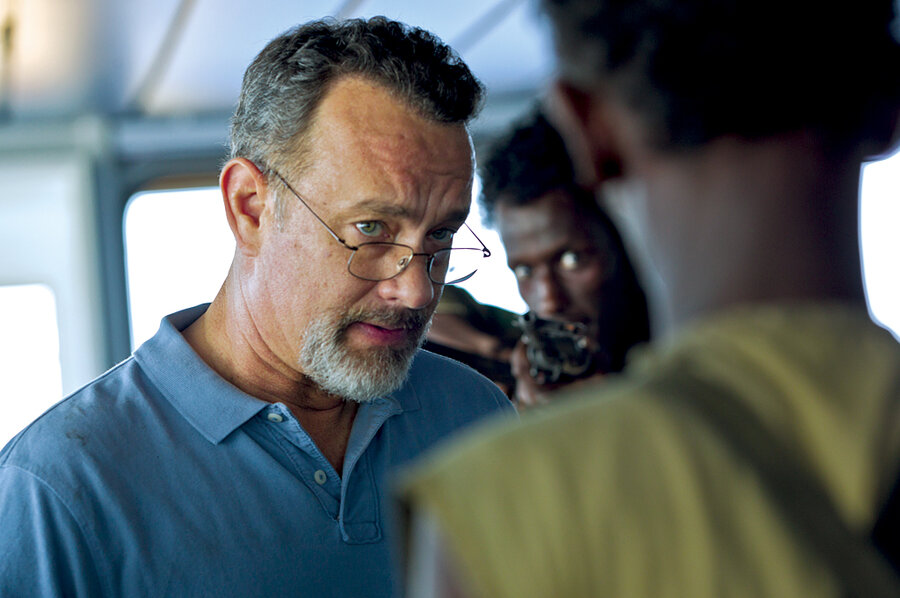'Captain Phillips' is some of Tom Hanks' most powerful acting ever
Loading...
Paul Greengrass, the director of “United 93,” “Bloody Sunday,” and two “Bourne” films, certainly knows how to put the screws to audiences. He makes movies featuring people under extreme duress and he wants us to sweat it out, too.
“Captain Phillips,” his latest exercise in high-tension theatrics, is not as pulpish as the “Bourne” movies or as politicized as “United 93” and “Bloody Sunday.” It’s based on the memoir of Capt. Richard Phillips, whose cargo ship, MV Maersk Alabama, was hijacked in 2009 in the waters off the coast of Somalia by Somali pirates while en route from Oman to Mombasa, Kenya. The hijacking, something of a botch-up, resulted in Phillips being kidnapped for ransom aboard a high-tech lifeboat bound for the Somali coast, with the US Navy and a crack SEAL team in hot pursuit.
Because Tom Hanks plays Phillips, the Everyman vibe is here from the get-go. We first see him leaving his Vermont home to catch a flight to the Middle East. Once aboard his ship, all too aware of the piracy dangers he faces, he issues crisp orders to reinforce security. When the cargo ship is chased down by pirates, he’s prepared – and aghast.
Especially in the “Bourne” movies, Greengrass has gone wild for bobbly, you-are-there camerawork that made me want to flee to the back row of the theater. (Why do filmmakers equate this technique with “realism”?) Thankfully, he’s toned it down here. The film is tautly engineered and, given the inherent claustrophobia of the situation, fluidly shot. The cat-and-mouse sequence in which the pirates search the lower reaches of the ship for the hidden crew is a model of thriller dynamics.
He also makes a point of giving the four pirates who commandeer the ship enough of a back story to flesh out their desperation. No terrorists, they are poor fishermen looking only to make a big score. Their leader is Muse, very well played by Barkhad Abdi, a Somali living in America and making his film debut. His hair-trigger anxiety is tempered by his grudging respect for Phillips – a fellow commander. As they try to outwit each other, a screwed-up esprit de corps develops between these two.
Hanks has always been good at playing average Joes, but what must have attracted him to this part was the chance to play an average Joe in mortal danger. As Phillips, he keeps a very tight hold on his temper. He knows he stands a better chance of surviving that way. When, near the end, he is rescued in a state of shock, all that normality breaks down and a real rawness comes through. It’s some of the most powerful acting Hanks has ever done.
My problem with “Captain Phillips,” albeit to a far lesser extent, is the same problem I had with “Zero Dark Thirty.” Greengrass and screenwriter Billy Ray have used a highly charged political backdrop to make, in essence, a glorified crime procedural. We never hear about why the international corporations funding these cargo ships allow the seamen to so perilously risk their lives. (And why aren’t there any guns on board?) You don’t have to be a cynic to realize that if the cargo ship had been from a less powerful country than the United States, no SEALs would have swooped in.
I was also made a bit uncomfortable by the way the four pirates, with their snarls and bulging eyes, seem at times a breed apart from the whites on board. This extends to the blacks we see on the beach in the city of Eyl before the pirates set out. The film skirts perilously close to “Heart of Darkness” territory – the enemy as Other.
It’s a tribute to the film’s galvanizing momentum that most of these reservations didn’t sink in for me until the film was over. Greengrass is an expert hijacker, too. He hijacks our good sense. Grade: B+ (Rated PG-13 for sustained intense sequences of menace, some violence with bloody images, and substance use.)





